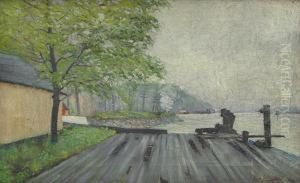Samuel Ostrowsky Paintings
Samuel Ostrowsky was a Russian-born painter, recognized for his contributions to modern art, particularly within the School of Paris, a term used to describe the community of foreign artists working in the French capital in the early 20th century. Born into a Jewish family in the Russian Empire, Ostrowsky's early life was marked by the challenges of his time, including the restrictions placed on Jewish people in Russia. Despite these obstacles, he nurtured a profound interest in art from a young age, which would eventually lead him to Paris, the then epicenter of the artistic world.
In Paris, Ostrowsky became part of a vibrant artistic community that included many Russian émigrés and Jewish artists. His work was influenced by the various movements of the time, including Cubism and Fauvism, yet he maintained a distinctive style characterized by bold colors, dynamic compositions, and a deep emotional resonance. Ostrowsky's subjects ranged from landscapes and urban scenes to Jewish life and culture, reflecting both his personal heritage and the broader human condition.
Throughout his career, Ostrowsky exhibited his work in various galleries and salons in Paris, contributing to the rich tapestry of modern art during a period of great creativity and experimentation. However, the outbreak of World War II and the subsequent occupation of France by Nazi Germany brought profound challenges to Ostrowsky and other Jewish artists. Despite these adversities, he continued to create art that celebrated life and human resilience.
Samuel Ostrowsky's legacy is that of an artist who bridged cultures and eras, bringing his unique perspective to the modernist movement. His work remains a testament to the power of art to transcend boundaries and to the enduring spirit of creativity in the face of hardship. Ostrowsky's paintings are now held in various private collections and museums, where they continue to be admired for their vibrancy, depth, and emotional impact.
